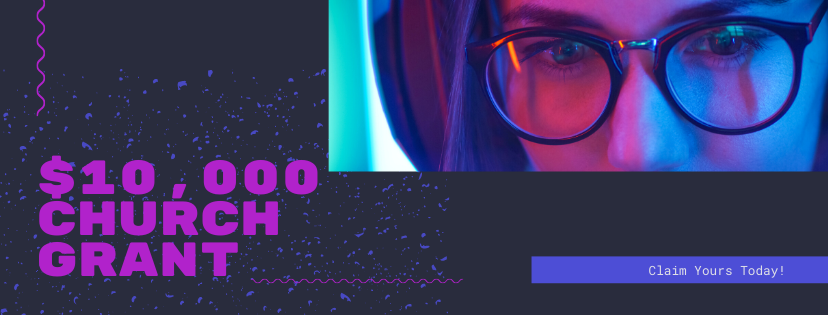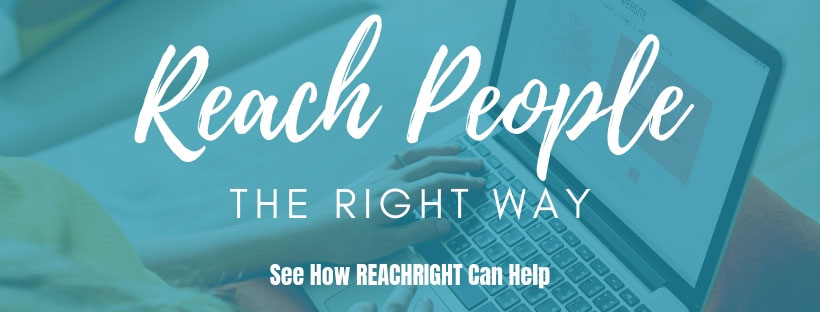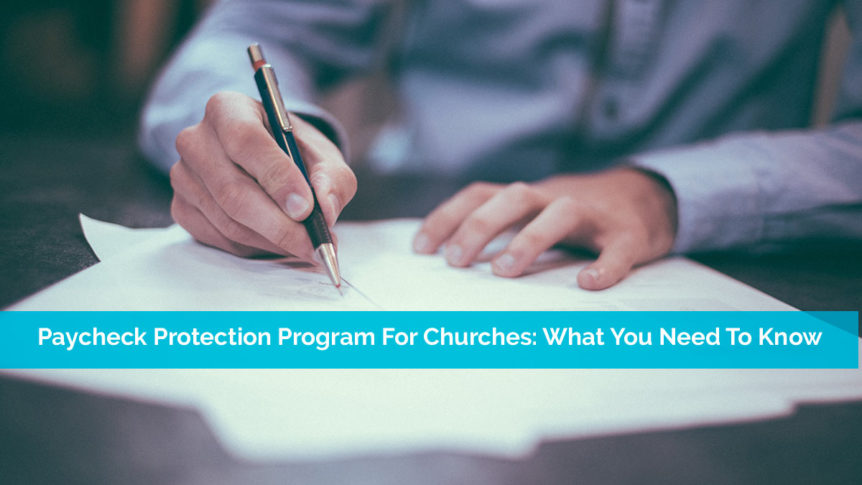UPDATE: You Can Download Your Paycheck Protection Program For Churches Application Here And Get Started Today – Application Form
UPDATE #2: You Can Find An Eligible Lender In Your Area For The Paycheck Protection Program For Churches Here – Lender Locator
With gatherings limited to under 50 and even 10 in some areas, many churches are struggling to make ends meet. The good news is the US government has introduced the Payment Protection Program for churches, small businesses, and other non-profits to help your stay afloat financially until this crisis subsides.
The worst part is no one knows for sure how long these restrictions will last. Even when restrictions are lifted, many people may still hesitate to go back to church at first for fear of getting sick.
It’s important to understand the new program and how it can help your church. Even more importantly, if it’s right for you, now’s the time to apply.

How Churches Are Suffering
At first, many people might not realize just how much churches are suffering. While they might not be a traditional business, churches typically operate on a shoestring budget. Much like small businesses, they have a core staff that earns a regular salary.
Going weeks without funds coming in hurts. Churches are being forced to make difficult decisions, such as:
- Deciding who to temporarily let go due to lack of money
- Paying for a way to reach members during COVID-19, such as live streaming services
- Continuing community outreach, such as delivering food to shut-ins and high-risk individuals
- Making rent on buildings
- Paying property taxes
- Paying regular utilities
Weekly tithes and regular events are what pays for all of these things. Suddenly, churches have no one coming in. Sadly, when no one’s coming in, many people don’t think about tithing. Plus, many members may be struggling as well without a job right now and have nothing to give.
Churches want to support their staff, but salaries add up without funds coming in. With the new Paycheck Protection Program for churches, other non-profits and small businesses, they may be able to pay their staff and keep the church going throughout the coronavirus.
Paycheck Protection Program Overview
At first, it might seem like the Paycheck Protection Program is just for small businesses, but the program is designed for:
- Small businesses with less than 500 employees (some businesses with over 500 employees are still considered small depending on the industry)
- Certain non-profits
- Tribal concerns
- Veterans organizations
- Sole proprietorships
- Independent contractors
- Self-employed individuals
The program gives eligible small businesses up to a $10 million loan to help with various expenses, including payroll. The best part is up to 100% of the loan is forgivable depending on how it’s used.
Any portion of the loan used to cover payroll, mortgage, rent and utilities is forgivable as long as employees are kept on the payroll for at least eight weeks. If employees are let go (they don’t have to actually still be working if they’re not needed, but they should still be getting paid), this will limit how much of the loan will be forgiven.

How The Loan Works
The Paycheck Protection Program for churches is a type of small business loan. One important aspect to pay attention to is the loan can’t be used in conjunction with another type of small business loan to cover the same expenses.
The loan is federally guaranteed and designed to be used to keep small businesses and non-profits economically sound during COVID-19. As such, it’s only for businesses directly affected by the coronavirus pandemic between February 15, 2020 and June 30, 2020.
When you apply for the loan, you might sign that the loan is for relief directly related to hardships caused by COVID-19. It must also be a necessary loan that you’ll use to cover operating expenses and payroll.
Part and in some cases all of your loan may be forgiven based on specific criteria, including:
- Only principal amounts during the first eight weeks of the loan will be forgiven. The eight week period begins when you’re approved for the loan.
- The loan is used to take care of payroll that remains under $100,000 per employee.
- The loan is being used to pay for rent and utilities.
- You’ll be paying necessary interest or payments towards obligations directly related to keeping your church running.
This doesn’t mean your entire loan is forgiven. Only the principal that’s used to pay for necessary expenses will be forgiven and only during the first eight weeks. You can continue using the loan to pay for necessary expenses after this point, but those amounts won’t be forgiven.
You’ll also need to return to pre-decline levels by June 30, 2020 in order for any loan amount to be forgiven.
The good news is you can bring back any church staff that you had to temporarily lay off and retroactively pay them back using the loan back to February 15, 2020. Since many businesses already had to let some employees go in February, the program offers the retroactive date in February.
The amount of the loan to be forgiven will also be reduced if you’re paying fewer staff than normal and/or you reduce their salaries by 25% or more during this time.
If you’re worried about any remaining debt, you’ll have ample time to pay it back in small payments. Remaining loan amounts must be paid back over a 10 year period with a 4% or less interest rate. There are no fees and payments won’t start for up to a year.
Understanding What The Funds Cover
Obviously, you’ll want to try and use the funds so that most, if not all, of your loan will be forgiven. There are two key things to remember to reduce your remaining debt.
First, don’t over-borrow. If you only have three employees and own the property, you’re not going to need hundreds of thousands of dollars. Carefully consider what you actually need to borrow to avoid over-extending yourself.
Second, use the funds from the Paycheck Protection Program for churches wisely. Now isn’t the time to invest in additions to your church. The government doesn’t see this as a necessity for balancing your hardship during COVID-19. Instead, you’re supposed to use the money to cover necessary operating expenses only.
Example of expenses that will reduce what you owe after the eight-week period include:
- Staff salaries
- Employee healthcare plans (if they already existed)
- Vacation and other leave time (you can likely skip this and just use the funds to pay your church staff as if they were working, even if they can’t right now)
- Any state and local taxes for employee pay
- Mortgage and rent costs for your building and property
- Interest on existing debt (the debt can’t be a simultaneous loan to help you through the coronavirus pandemic)
- Utilities (It’s okay to continue using your church with limited staff to maintain it and offer remote services. There’s no reason to limit your utility use to save money as the loan will cover it.)
As a good rule of thumb, if it’s a necessary expense for running your church normally, the loan likely covers it. However, always read the fine print to ensure you’re using the funds correctly.
Technically, you can use the loan for other things related to your church. However, any amount you use for other things won’t be forgiven and you will have to pay it back with interest.

Determining Eligibility
Most churches should qualify. The main limit is you have 500 employees or less. Since the majority of churches don’t have anywhere close to this many employees, you should be eligible.
Obviously, you should speak with your lender to determine eligibility completely. Even if you only have a few full-time staff members, don’t be afraid to apply. The costs of maintaining the church during this crisis will add up if you don’t have the funds to cover it. You don’t have to be a larger church with dozens of staff members to apply.
When determining the eligibility of the Payment Protection Program for churches loans, prepare your financial records to show your lender. You should have the past year available to show your bills and salaries.
If you’re a newer church, you’re still eligible as long as you started before February 15, 2020. You should still provide financial documents from your start date to help determine full eligibility and help your lender in determining how much you may need.
Help From Members
Right now, it’s not always easy to get help from your church members. Many are dealing with the same issues as your church. They might have been let go temporarily and are struggling to get unemployment. As such, they might not have anything extra to donate.
However, encourage any members who can still help out to tithe online. Set up a section on your website for them to securely tithe or even just give a one-time donation.
During this time, continue blogging and using social media. With so many people at home, you’ll reach a larger audience. Even non-members who enjoy your website may consider donating to help out.
Let your members and site visitors know that under the CARES Act, which includes the Payment Protection Program details, Americans can donate up to $300 to charities and non-profits during COVID-19 and deduct the full $300 from their 2020 taxes. Even if people don’t itemize their deductions, the $300 deduction is still applicable. This may encourage more people to donate.
Is The PPP Right For Your Church
This is a big question your church has to consider. While the Payment Protection Program for churches sounds great, it might not be right for your church. Many churches consider it a sin to take on any real debt. It may also go against your church’s bylaws.
Take the time to discuss this among your church leaders to figure out the best options for you. The most important thing to consider is the well-being of your paid staff. Are they able to make it without a paycheck while your church is closed? Are you able to continue paying those who are still working?
When you borrow the right amount and use it the way it’s intended, you shouldn’t have much to pay back. Also, remember, the coronavirus is a disaster that’s affected the entire world. Never before has the world had to essentially close down, which leaves businesses and churches in a unique situation.
Consider the pros and cons and do what is best for your church and staff. If you have any questions, talk to your local bank or lender for more details.

Steps To Take Now
The loans are on a first-come, first-served basis, so apply as soon as possible if you believe your church needs a loan. Funds are limited to $349 billion under the current CARES Act. With so many businesses and non-profits needing help, those billions may go quickly. Experts believe additional funds might be added later on.
There are several things you need to do as soon as possible if you believe your church needs a loan:
- Discuss the idea with your church leaders and staff. You can even ask your members what they think.
- Prepare your financial data. This includes payroll of the last year, or your payroll since you opened if you’re under a year old.
- Contact your accountant, if you have one, for details on financials and the loan.
- Contact your local bank or lender to set up a virtual appointment.
- Use your financials and advice from your lender to choose an appropriate amount.
When applying, ensure you go over all the fine print. This would include looking at what is and isn’t forgivable, the forgiveness period, repayment terms, interest rates and more.
Continue Ministering
Most importantly, continue ministering if possible throughout the coronavirus outbreak. Your members and online community need you right now more than ever. Some ways to stay connected right now include:
- One-on-one video chats or small group video chats
- Blogging regularly (now’s a great time for several posts per week) to support and motivate readers
- Posting frequently on social media
- Interacting with followers on social media.
- Setting up special social media groups for different age groups
- Calling members who may be struggling
- Live streaming services (even if it’s just the pastor and someone filming)
- Posting inspiring reading on social media or doing link round-ups on your blog
- Hosting Q&A sessions on social media, your website or even Reddit
If you want to make changes to your church website to make it easier to reach people during COVID-19, contact us today to find out how we can help. We want nothing more than to help you reach your church family during this difficult time so everyone can get through this together.





Comments 4
Hello, I’ve attempted to complete an application for the Payroll Protection Program on few occasions; however there’s a question regarding the percentage of ownership. We are a non-profit 501c3 church and the ministry is owned by the members. The application cannot be completed online if I leave it blank or enter zero! Please help!!
Thank you!
Author
Great question Rita! That line is for businesses where there are multiple owners. In your case, we recommend filling it as 100% ownership, as you are representing 100% of the organization.
Hello I would like more information on this, I pastor a small growing ministry in Las Vegas, I could definitely use the assistance
Author
The Small Business Administration just released the application. You can get started on it today. https://www.sba.gov/sites/default/files/2020-04/PPP%20Borrower%20Application%20Form.pdf